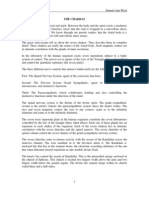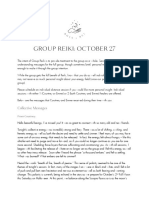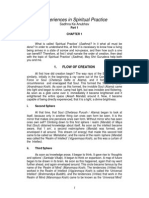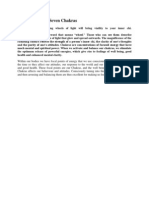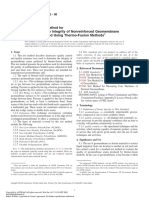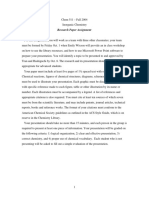Chakras
Chakras
Uploaded by
Ravindra GadhariCopyright:
Available Formats
Chakras
Chakras
Uploaded by
Ravindra GadhariOriginal Description:
Original Title
Copyright
Available Formats
Share this document
Did you find this document useful?
Is this content inappropriate?
Copyright:
Available Formats
Chakras
Chakras
Uploaded by
Ravindra GadhariCopyright:
Available Formats
Chakras
The word comes from the Sanskrit cakra meaning "wheel" or "circle" (also cognate to both words), and sometimes also referring to the "wheel of life". The pronunciation of this word can be approximated in English by chuhkruh, with ch as in chart and both instances of a as in yoga (the commonly found pronunciation shockrah is incorrect). Some traditional sources describe five or seven chakras, others eight. The chakras are described as being aligned in an ascending column from the base of the spine to the top of the head. In new age practices, each chakra is associated with a certain color. In various traditions chakras are associated with multiple physiological functions, an aspect of consciousness, a classical element, and other distinguishing characteristics. They are visualized as lotuses with a different number of petals in every chakra. The chakras are thought to vitalise the physical body and to be associated with interactions of a physical, emotional and mental nature. They are considered loci of life energy, or prana, (also called shakti, or chi), which is thought to flow among them along pathways called nadis. The function of the chakras is to spin and draw in this Universal Life Force Energy to keep the spiritual, mental, emotional and physical health of the body in balance. Traditional Chinese medicine also relies on a similar model of the human body as an energy system. The New Age movement has led to an increased interest in the West regarding chakras. Many in this movement point to a correspondence between the position and role of the chakras and those of the glands in the endocrine system. Some people in New Age also claim that other chakras, besides the above, exist for instance, ear chakras and have described many more chakras than made reference to in traditional texts. Frequently references are made to the chakras in the New Age "sacred sexuality" or neotantra movement. The chakras are described in the tantric texts the Sat-Cakra-Nirupana, and the Padaka-Pancaka, in which they are described as emanations of consciousness from Brahman, an energy emanating from the spiritual which gradually turns concrete, creating these distinct levels of chakras, and which eventually finds its rest in the Muladhara chakra. They are therefore part of an emanations theory, like that of the kabbalah in the west, lataif-e-sitta in Sufism or neoplatonism. The energy that was unleashed in creation, called the Kundalini, lies coiled and sleeping at the base of the spine. It is the purpose of the tantric or kundalini forms of yoga to arouse this energy, and cause it to rise back up through the increasingly subtler chakras, until union with God is achieved in the Sahasrara chakra at the crown of the head.
Apart from this primary text from India, different Western authors have tried to describe the chakras, most notably the Theosophists. Many New Age writers, such as the Danish author and musician Peter Kjaerulff in his book, The Ringbearer's Diary, or Anodea Judith in her book Wheels of Life, have written their opinions about the chakras in great detail, including the reasons for their appearance and functions. The seven chakras are said by some to reflect how the unified consciousness of humanity (the immortal human being or the soul), is divided to manage different aspects of earthly life (body/instinct/vital energy/deeper emotions/communication/having an overview of life/contact to God). The chakras are placed at differing levels of spiritual subtlety, with Sahasrara at the top being concerned with pure consciousness, and Muladhara at the bottom being concerned with matter, which is seen simply as crude consciousness.
Origins and development
The earliest known mention of chakras is found in the later Upanishads, including specifically the Brahma Upanishad and the Yogatattva Upanishad. These vedic models were adapted in Tibetan Buddhism as Vajrayana theory, and in the Tantric Shakta theory of chakras.[citation needed] It is the shakta theory of 7 main chakras that most people in the West adhere to, either knowingly or unknowingly, largely thanks to a translation of two Indian texts, the Sat-Cakra-Nirupana, and the Padaka-Pancaka, by Sir John Woodroffe, alias Arthur Avalon, in a book entitled The Serpent Power. This book is extremely detailed and complex, and later the ideas were developed into what is predominant western view of the Chakras by the Theosophists, and largely the controversial (in theosophical circles) C. W. Leadbeater in his book The Chakras, which are in large part his own meditations and insights on the matter. That said, many present-day Indian gurus that incorporate chakras within their systems of philosophy do not seem to radically disagree with the western view of chakras, at least on the key points, and both these eastern and western views have developed from the Shakta Tantra school. There are various other models of chakras in other traditions, notably in Chinese medicine, and also in Tibetan Buddhism. Even in Jewish kabbalah, the different Sephiroth are sometimes associated with parts of the body. In Islamic Sufism, Lataif-e-Sitta ( Six Subtleties ) are considered as psychospiritual "organs" or faculties of sensory and suprasensory perception, activation of which makes a man complete. Attempts are made to try and reconcile the systems with each other, and notably there are some successes, even between such diverged traditions as Shakta Tantra, Sufism and Kabbalism, where
chakras, lataif and Sephiroth can seemingly represent the same archetypal spiritual concepts. In Surat Shabda Yoga, initiation by an Outer Living Satguru (Sat - true, Guru - teacher) is required and involves reconnecting soul to the Shabda and stationing the Inner Shabda Master (the Radiant Form of the Master) at the third eye chakra.
The Seven basic chakras
Sahasrara Sahasrara or the crown chakra is said to be the chakra of consciousness, the master chakra that controls all the others. Its role would be very similar to that of the pituitary gland, which secretes hormones to control the rest of the endocrine system, and also connects to the central nervous system via the hypothalamus. The thalamus is thought to have a key role in the physical basis of consciousness. Symbolized by a lotus with a thousand petals. Ajna Ajna or the third eye is linked to the pineal gland. Ajna is the chakra of time and awareness and of light. The pineal gland is a light sensitive gland, that produces the hormone melatonin, which regulates the instincts of going to sleep and awakening. It has been conjectured that it also produces trace amounts of the psychedelic chemical dimethyltryptamine. Symbolized by a lotus with two petals. (Note: some argue that the pineal and pituitary glands should be exchanged in their relationship to the Crown and Brow chakras, based on the description in Arthur Avalon's book on kundalini called Serpent Power or empirical research.) Vishuddha Vishuddha or the throat chakra is said to be related to communication and growth, growth being a form of expression. This chakra is paralleled to the thyroid, a gland that is also in the throat, and which produces thyroid hormone, responsible for growth and maturation. Symbolized by a lotus with sixteen petals. Anahata Anahata or the heart/emotions chakra is related to love, equilibrium, and wellbeing. It is related to the thymus, located in the chest. This organ is part of the immune system, as well as being part of the endocrine system. It produces T cells responsible for fighting off disease, and is adversely affected by stress. Symbolized by a lotus with twelve petals.
Manipura Manipura or the solar plexus chakra is related to energy, assimilation and digestion, and is said to correspond to the roles played by the pancreas and the outer adrenal glands, the adrenal cortex. These play a valuable role in digestion, the conversion of food matter into energy for the body. Symbolised by a lotus with ten petals. Swadhisthana Swadhisthana or the sacral chakra is located in the groin, and is related to emotion, sexuality and creativity. This chakra is said to correspond to the testicles or the ovaries, that produce the various sex hormones involved in the reproductive cycle, which can cause dramatic mood swings. Symbolised by a lotus with six petals. Muladhara Muladhara or the base or root chakra is related to security, survival and also to basic human potentiality. This center is located in the region between the genitals and the anus. Although no endocrine organ is placed here, it is said to relate to the inner adrenal glands, the adrenal medulla, responsible for the fight and flight response when survival is under threat. In this region is located a muscle that controls ejaculation in the sexual act. A parallel is drawn between the sperm cell and the ovum, where the genetic code lies coiled, and the kundalini. Symbolized by a lotus with four petals.
The Tantric Chakras
1. 2. 3. 4. 5. 6. 7. 8. 9. Tantric chakras Sahasrara Ajna Vishuddha Anahata Manipura Swadhisthana Muladhara Bindu
Tantra (Shakta or Shaktism) describes eight primary inner chakras: 1. 2. 3. 4. 5. Sahasrara Ajna Vishuddha Anahata Manipura
6. Swadhisthana 7. Muladhara 8. Bindu Buddhiyoga is the practice of uniting the mind with the higher consciousness through the proper use of buddhi, the power of discretion and understanding. Buddhiyoga enables us to use the faculties of our minds effectively for selfrealization. Through Buddhiyoga we learn to control the senses and quite the mind. We learn to discriminate the right from the wrong and the appropriate from the inappropriate. We also become conscious of the nature of the the three gunas and the movement of the breath and other energies in our physical and mental bodies. The Bhagavadgita deals with the concept of buddhiyoga in greater detail. In the following paragraphs we have presented a brief description of buddhiyoga as explained in the Bhagavadgita. According to the Bhagavadgita, even mindedness is called Buddhiyoga (2.48). It is difficult to achieve because of the conditions in which we live. Our minds remain mostly disturbed and preoccupied with some problem or the other. According to the Bhagavad-Gita, equanimity of mind should be cultivated by practicing control of the mind, the body and the senses through inner discipline and detachment. Even mindedness culminates in samadhi, the state of equality, where one is beyond the senses, the sense of all duality and completely immersed in himself, unaware of and detached from the external world. It is the yoga which finally brings "dukha samyoga viyogam" (disconnections from the union with pain) ( 6.23) "Buddhi" is the intelligence that exists in all of us in contrast to 'chitta" or pure consciousness. Buddhi gives us the power to discriminate and decide what is good for us and what is not. It is the force behind our wisdom and our reactions to the outside world. A man of lesser buddhi is constantly driven by the senses and the desire for sense objects. He thereby remains in a constant state of turmoil and sorrow arising out of union and disunion with the sense objects. So buddhiyoga teaches us how to overcome this weakness of the mind and achieve the state of equanimity so that one can remain alike in pleasure and pain, gain and loss, victory and defeat (2.38) and thereby remain free from the bondage of all actions(2.39). Disinterested action through "vyavasayatmika buddhi (cultivated mind) is the aim of buddhiyoga. In this path there is no loss of effort. Even a little practice protects one from the fear of birth and death (2.40). Perfection in this path cannot be achieved by the mere study of the Vedas or engaging oneself in flowery speeches and debates (2.42), without necessary effort to control ones desires and detaching oneself from pleasure and power. It is by overcoming the three gunas enumerated in the Vedas, by conquering the sense of duality and by establishing oneself in sattva one can obtain enlightenment (2.45). By
developing even mindedness in success and failure, renouncing the fruit of actions, detached, the buddhiyogi becomes free from bondage of mortal life. (2.48-51). How to know whether one has achieved perfection in this path ? What are the marks of a true "sthithapragna "(expert in stability) ? The yogi of stable mind gives up all cravings of the mind, withdrawn and satisfied in himself (2.55). He is not afraid of adversity, nor does he crave for happiness. He is the stabilized sage (sthithadhir muni), who is free from passion, fear and anger (2.56). Without friends or relations (anabhisneha), equal to auspicious and inauspicious events, he remains detached, unconcerned and absorbed in himself (2.57). The senses are responsible for the delusion and the disturbances of the mind. By establishing contact with the outside world, the senses bind the mind to the sense objects. Out of this attachment is born the desire for the sense objects. Out of this desire arise passions, delusion, anger, loss of memory, confusion and finally loss of buddhi or intelligence (2.62&63). Knowing this the Buddhiyogi tires to achieve stability of mind by withdrawing the mind form the sense objects, the way a tortoise withdraws its limbs (2.58). He stops enjoying the sense objects and thereby ends all his sorrow. By controlling his senses, devoting himself, heart and soul to God , he becomes firmly established in God (2.65). He becomes the awakened Yogi, who is awake (spiritually) when all beings are asleep (in ignorance) and who is asleep (mentally) when all being are awake in the world of desires (2.69). He becomes the ocean itself, undisturbed by the rivers of information flowing into him from all sides (2.70). To achieve such a Brahmic State through buddhiyoga, one has to practice atmasamyamayoga or the yoga of self discipline which is described in the sixth chapter (10-19). The yogi should concentrate his mind constantly on his Self, leading a solitary life, controlling his mind, free from desires and possessiveness. Placing his firm seat in a clean place, neither too low nor too high, covering it with soft clothe, deer skin and kusa grass, he should practice yoga for self purification, keeping his mind, senses and activities under firm control. Holding the body, the neck and the head straight in one line, concentrating his gaze on the tip of his nose, undistracted, with peaceful mind, fearless, practicing celibacy, subdued in passions, he should becomes become established in God and attain highest peace and nirvana (6.10-15). There is no place for extremities in this yoga (6.16-18). This yoga is neither for the voracious eater nor for the non-eater. It is neither for the constant sleeper nor for the chronic insomniac. The buddhi yogi who is regulated in diet and relaxation, in sleeping and waking, becomes impervious to all sorrow. Resting in the self alone, freed from all desires, he becomes established in the yoga of equanimity. In that state, he realizes his hidden Self, becomes satisfied in the
Self (6.20), finds unlimited happiness, develops an understanding of the transcendental state through his pure intellect and remains immobile to all sorrow. He enjoys the extreme bliss of union with Brahman and develops the unified vision of the Universal Self, seeing the Self in all and all in the Self (6.21-29). Buddhiyoga is the the foundation for success and perfection in all other paths. Without self control and discipline of the mind, success in the three paths of knowledge, action and devotion is not possible. A true karmayogi has to control his desires and develop detachment to be able to become a true sanyasi and offer the fruit of his actions to God with a true sense of sacrifice (3.7&5.3). A true devotee of God must be able to control his mind and desires so by truly detaching himself from all and attaching himself only to God, he can concentrate his mind on Him and become absorbed in Him completely (Chapter 9&12).
You might also like
- How To Be Good at Science, Technology and Engineering Workbook 1, Ages 7-11 (Key Stage 2) The Simplest-Ever Visual Workbook (DK) (Z-Library)Document177 pagesHow To Be Good at Science, Technology and Engineering Workbook 1, Ages 7-11 (Key Stage 2) The Simplest-Ever Visual Workbook (DK) (Z-Library)Anamaria Radu100% (3)
- 7200 User Manual-Aeonmed PDFDocument92 pages7200 User Manual-Aeonmed PDFArtur Florián100% (2)
- Honeywell Elster A1140 Smartset ManualDocument62 pagesHoneywell Elster A1140 Smartset ManualYoco ChocoNo ratings yet
- Chakra TestDocument1 pageChakra TestNajlepše PesmiNo ratings yet
- Chakras: Index PageDocument10 pagesChakras: Index PagenomiapsNo ratings yet
- The Chakras: Individual Study of The Chakras: Muladhara Chakra or Church of EphesusDocument7 pagesThe Chakras: Individual Study of The Chakras: Muladhara Chakra or Church of EphesusBob MarinoNo ratings yet
- The ChakrasDocument9 pagesThe ChakrasdragosbalaniucNo ratings yet
- E Lunar7 11Document2 pagesE Lunar7 11Stefaan Van NuffelNo ratings yet
- Chakras and Lotuses: Etheric Whirlpools of ForceDocument2 pagesChakras and Lotuses: Etheric Whirlpools of ForceStefaan Van Nuffel100% (1)
- Impulse and Impulsivity: Stimulation of KarmaDocument2 pagesImpulse and Impulsivity: Stimulation of KarmaStefaan Van NuffelNo ratings yet
- E Lunar9 3Document2 pagesE Lunar9 3Stefaan Van NuffelNo ratings yet
- Reiki ChakrasDocument6 pagesReiki ChakrasSumit TalwarNo ratings yet
- Number Seven: Numbers - Potencies of NatureDocument2 pagesNumber Seven: Numbers - Potencies of NatureStefaan Van NuffelNo ratings yet
- Aura 1Document2 pagesAura 1s_badar85No ratings yet
- Agya Chakra and Your PersonalityDocument7 pagesAgya Chakra and Your PersonalityDrGarima Saxena MehtaNo ratings yet
- Energetic System - IHRDocument6 pagesEnergetic System - IHREulysses Edquilag100% (1)
- Asanas For The Chakra System: Seventh HeavenDocument10 pagesAsanas For The Chakra System: Seventh HeavenA LunaNo ratings yet
- Chakra Colors & InfoDocument2 pagesChakra Colors & InfodayoayoolaNo ratings yet
- Signs of Transformation 5: The Base CentreDocument2 pagesSigns of Transformation 5: The Base CentreStefaan Van NuffelNo ratings yet
- Root ChakraDocument7 pagesRoot ChakraAlexandros KatsonisNo ratings yet
- Spiritual Wisdom Moving Beyond ReligionDocument71 pagesSpiritual Wisdom Moving Beyond ReligionPenny Falgout100% (1)
- Blue Spectral Eagle 11Document4 pagesBlue Spectral Eagle 11mimi ciciNo ratings yet
- Psychic 3Document13 pagesPsychic 3Stanley EzechukwuNo ratings yet
- The Antahkarana: Inner and Outer InstrumentsDocument2 pagesThe Antahkarana: Inner and Outer InstrumentsTech55No ratings yet
- Kriya-Yoga For A Happy Life ADocument5 pagesKriya-Yoga For A Happy Life Asudha0218No ratings yet
- The Abbott's: Correspondence School of New Age StudiesDocument16 pagesThe Abbott's: Correspondence School of New Age StudiesRaizaNo ratings yet
- Reiki Is The Gift of Vitality and Self Preservation Encoded Into The Genetic MakeupDocument2 pagesReiki Is The Gift of Vitality and Self Preservation Encoded Into The Genetic MakeupvirendhemreNo ratings yet
- Lesson 3 PranayamaDocument3 pagesLesson 3 Pranayamagur14No ratings yet
- Ascension 4 ManualDocument11 pagesAscension 4 Manualcamille bastienNo ratings yet
- TreyreyyeDocument63 pagesTreyreyyecredo99No ratings yet
- Clean Your Chakras, Clean Your Life! by Reena Johar: New Chakra Research Challenges SkepticsDocument5 pagesClean Your Chakras, Clean Your Life! by Reena Johar: New Chakra Research Challenges SkepticsAditi RosyNo ratings yet
- Rainbow Bridge Clearing.Document5 pagesRainbow Bridge Clearing.Kulwinder SinghNo ratings yet
- Archangel Michael GuidebookDocument13 pagesArchangel Michael GuidebookJoana CavacoNo ratings yet
- Night Affirmations PDFDocument1 pageNight Affirmations PDFPriyaNo ratings yet
- Lesser Gifts: Space Scalpel On TurnDocument7 pagesLesser Gifts: Space Scalpel On TurnfenrisNo ratings yet
- Energy AbsorbingDocument8 pagesEnergy Absorbingאקי להמןNo ratings yet
- The Science of Breathing and White Magic December 3 2015Document7 pagesThe Science of Breathing and White Magic December 3 2015Iroro UyovbukerhiNo ratings yet
- Energetic Kinesiology35Document1 pageEnergetic Kinesiology35Marius Dan GiolgauNo ratings yet
- Group Reiki: October 27: Collective MessagesDocument9 pagesGroup Reiki: October 27: Collective Messagess05xoNo ratings yet
- E Astro Aries 4Document2 pagesE Astro Aries 4Aristid HavlicekNo ratings yet
- Spiritualist Basics - Joseph Loffredo JRDocument16 pagesSpiritualist Basics - Joseph Loffredo JRJeNo ratings yet
- An Extensive and Practical Guide For Kundalini Awakening From A Yogic and Sufi Perspective.Document41 pagesAn Extensive and Practical Guide For Kundalini Awakening From A Yogic and Sufi Perspective.Kazi Raiyan100% (1)
- RYVDocument121 pagesRYVwilliam_trentini5457No ratings yet
- Ascension 1 ManualDocument10 pagesAscension 1 Manualcamille bastienNo ratings yet
- Energy Healing Cleanse Workbook: An Online CourseDocument10 pagesEnergy Healing Cleanse Workbook: An Online CourseDiana Pascu100% (1)
- Spiritual ExperienceDocument80 pagesSpiritual ExperiencedoctorsujitNo ratings yet
- Swami Sivananda Dhyana PDFDocument2 pagesSwami Sivananda Dhyana PDFjambu99No ratings yet
- Mantra Meditation and Self RealizationDocument14 pagesMantra Meditation and Self RealizationJeyashankar RamakrishnanNo ratings yet
- Dragon Sky Manual: Jezael's Ray of HelpDocument2 pagesDragon Sky Manual: Jezael's Ray of HelpIo YahiyaNo ratings yet
- ChakrasDocument6 pagesChakrassadasd32cxvNo ratings yet
- 2 Paths To Enlightenment by Ven Maha PrasertDocument14 pages2 Paths To Enlightenment by Ven Maha PrasertBro CheahNo ratings yet
- What Is A Light Body - The Acolyte of AscensionDocument12 pagesWhat Is A Light Body - The Acolyte of AscensionOana TI100% (3)
- Divine God Layers (Dna Group Four) 10. Divine Belief Layer - Call To DivinityDocument2 pagesDivine God Layers (Dna Group Four) 10. Divine Belief Layer - Call To Divinityகாட்டு வாசிNo ratings yet
- Root Chakra - Prva CakraDocument9 pagesRoot Chakra - Prva CakraAna ZivojinovicNo ratings yet
- Clearing Vows and Contracts From The Akashic Records Body Mind Soul 2Document1 pageClearing Vows and Contracts From The Akashic Records Body Mind Soul 2Petra CsetnekiNo ratings yet
- Stimulating Your Inner ChiDocument7 pagesStimulating Your Inner ChiAaron SteeleNo ratings yet
- Chakra Test ResultsDocument16 pagesChakra Test Resultsminjacob_601721240No ratings yet
- A1 - What Sensed in AuraDocument6 pagesA1 - What Sensed in AuraReeshabhdev GauttamNo ratings yet
- Whispers of Eternity: Exploring the Mysteries of Death, Reincarnation, and the AfterlifeFrom EverandWhispers of Eternity: Exploring the Mysteries of Death, Reincarnation, and the AfterlifeNo ratings yet
- Guided Mindfulness Meditations for Deep Sleep, Overcoming Anxiety & Stress Relief: Beginners Meditation Scripts For Relaxation, Insomnia& Chakras Healing, Awakening& BalanceFrom EverandGuided Mindfulness Meditations for Deep Sleep, Overcoming Anxiety & Stress Relief: Beginners Meditation Scripts For Relaxation, Insomnia& Chakras Healing, Awakening& BalanceNo ratings yet
- 1 - Pharmaceutical Dosage Forms-AmnededDocument53 pages1 - Pharmaceutical Dosage Forms-AmnededhefikurniasariNo ratings yet
- American Woodworker - How To Make Bookshelves Bookcases (American Woodworker, Randy Johnson) (Z-Library)Document183 pagesAmerican Woodworker - How To Make Bookshelves Bookcases (American Woodworker, Randy Johnson) (Z-Library)alejuan252No ratings yet
- GYRD NotificationDocument11 pagesGYRD Notificationsowdha86No ratings yet
- Pass Critical Care Liver GITDocument49 pagesPass Critical Care Liver GITyorghiLNo ratings yet
- 1gw - Bc547, Bc847 Series NXPDocument15 pages1gw - Bc547, Bc847 Series NXPKlebber MarchettoNo ratings yet
- The Bull Grin Company Produces A Feed Supplement For AnimalDocument1 pageThe Bull Grin Company Produces A Feed Supplement For AnimalAmit PandeyNo ratings yet
- Genealogies of Islamic Radicalism in Post-Suharto IndonesiaDocument39 pagesGenealogies of Islamic Radicalism in Post-Suharto IndonesiaNazrul ImanNo ratings yet
- Bub323z DDocument8 pagesBub323z Dtomoyo2009No ratings yet
- Elsa Elephants Partner Selection 14 Sep 22Document47 pagesElsa Elephants Partner Selection 14 Sep 22Prakash SashaNo ratings yet
- Gps Receiver Design TutorialDocument3 pagesGps Receiver Design TutorialPete100% (1)
- Final Commissioning PlanDocument1 pageFinal Commissioning PlanHumaid ShaikhNo ratings yet
- FSM - mr3456 - Caution of GM Board PositionDocument4 pagesFSM - mr3456 - Caution of GM Board PositionQuang MinhNo ratings yet
- Astm d6392Document6 pagesAstm d6392Danilo Rojas MartinezNo ratings yet
- QuestionDocument4 pagesQuestionkaushal.mdb85No ratings yet
- Pnaag078 PDFDocument394 pagesPnaag078 PDFUzair Bukhari0% (1)
- Introduction To Gis Using Arcgis: Student EditionDocument6 pagesIntroduction To Gis Using Arcgis: Student EditionKélibiano FirasNo ratings yet
- Rindha, Hairil AkbarDocument8 pagesRindha, Hairil Akbarjaemin naNo ratings yet
- MCQ 1 PDFDocument19 pagesMCQ 1 PDFPravin SamalNo ratings yet
- Research Paper Organicx ChemistryDocument2 pagesResearch Paper Organicx ChemistryShirlyn Navarro RamirezNo ratings yet
- Catalogo Estetoscopio Welch AllynDocument5 pagesCatalogo Estetoscopio Welch AllynSilmara SilvaNo ratings yet
- AbstractDocument13 pagesAbstractchandu56No ratings yet
- ASEAN 2018 Notional CalendarDocument27 pagesASEAN 2018 Notional CalendarDo Duy KhanhNo ratings yet
- NiceVision Net 2.5 Product Suite BrochureDocument4 pagesNiceVision Net 2.5 Product Suite BrochurefakesasoNo ratings yet
- Linguistic Situation in USADocument29 pagesLinguistic Situation in USAAbderrahimNo ratings yet
- First Order ODE Forced OscillationsDocument2 pagesFirst Order ODE Forced OscillationsDerek WangNo ratings yet
- Chapter 5 Reviewer HboDocument3 pagesChapter 5 Reviewer HboJaireh ManuelNo ratings yet
- Programmable Logic Controllers - Basic PLC ComponentsDocument2 pagesProgrammable Logic Controllers - Basic PLC ComponentsGalco IndustrialNo ratings yet






